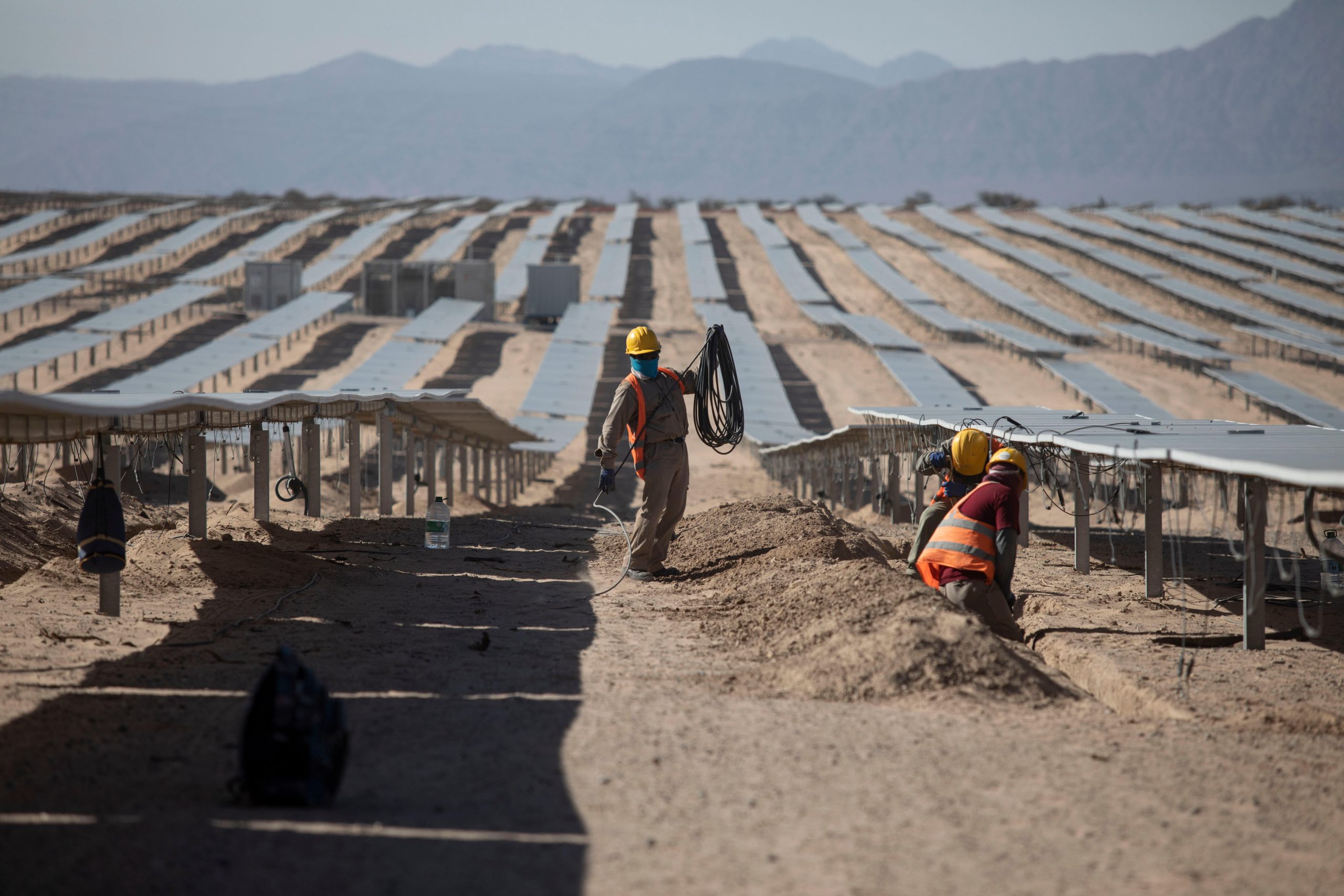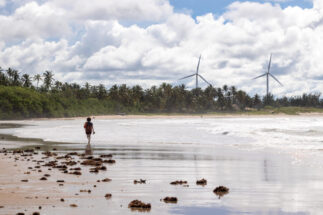A simple reallocation of the state subsidies currently granted to fossil fuel projects would be sufficient to finance Argentina’s transition to renewables, and help the nation reach carbon neutrality by 2050, research by the Universidad Nacional del Centro (UNICEN) in Buenos Aires province has found.
US$500 billion
Based on averages from 2017–2021, Argentina could allocate almost US$500 billion in fossil fuel subsidies by 2050, according to projections from UNICEN
To arrive at this conclusion, the study projected almost US$500 billion in budget allocations for fossil fuel subsidies up to mid-century – an average of US$16.6 billion per year – to support oil and gas production and energy generation from thermal power plants. The figure is based on averages from 2017–2021. Researchers then analysed the comparative savings under three different energy finance scenarios in Argentina.
The first is business-as-usual (BAU), and includes subsidies for confirmed new power plants, energy efficiency measures and energy infrastructure. The other two are zero-emissions alternatives: one based on electrification solely with renewables, the other includes biofuels. Both envisage the introduction of large amounts of renewable energy for electricity generation and green hydrogen production.
Study authors Daniela Keesler, Nicolás Diaz and Gabriel Blanco, did not, however, include new nuclear power plants or new hydroelectric dams as factors in their conclusions, due to the social and environmental concerns surrounding them.
In sum, the money allocated to fossil fuel subsidies would cover between 58% and 100% of the costs of electricity transmission lines – one of the major costs of the transition – under a renewable energy-based electrification scenario. Therefore, the money to finance much of the transition is already there. The issue is redirecting it.
Renewables generate savings
Argentina currently has 15 GW of installed renewable energy capacity. In order to meet its international carbon neutrality commitments under the Paris Agreement, the country would have to increase this capacity exponentially, to around 240 GW, according to the UNICEN study.
However, the costs of employing renewables to electrify the network are 21% lower than in the BAU scenario. In real terms, that would be a saving of US$508 billion.
“The greatest savings are made by no longer consuming fossil fuels, both for final demand and for electricity generation,” the report reads. “The biggest costs occur in areas such as infrastructure, due to the need for new power transmission lines or the installation of electric vehicle chargers. The large incorporation of electricity generation from renewable sources also generates higher costs, but by 2050 the [renewables-based] alternative scenario is the least costly.”
Subsidies on the rise
During the previous decade (2010–2019), and as noted in the 2021 Climate Transparency Report, fossil fuel subsidies in Argentina peaked in 2015 and then declined steadily, reaching a historic low of US$5.3 billion in 2019.

“Over this period, most of the subsidies were directed to supporting the production and consumption of petroleum, followed by natural gas production and consumption, and the consumption of fossil-fuelled electricity,” the report reads.
Of Argentina’s US$5 billion spent on fossil fuel subsidies in 2019, 76% went to oil, Climate Transparency reported. “Although fewer dollars were spent than in previous years, the [2018] currency devaluation means that every year Argentina spends more pesos on fossil fuel subsidies,” the authors noted.
While the country introduced a 2018 carbon tax on liquid fuels, it did not tax natural gas, the most widely used fossil fuel in the country.
According to Energy Policy Tracker data cited by Climate Transparency, Argentina allocated at least US$1.36 billion to fossil fuel energy in 2020 as part of its energy-related financing commitments and response to the impacts of the Covid-19 pandemic.
“This includes the earmarking of 25% of the revenue from the extraordinary once-off tax imposed on the wealthiest in the context of the Covid-19 pandemic to support gas extraction and exploration by the state-owned enterprise Yacimientos Petrolíferos Fiscales (YPF),” the report said.
Furthermore, the fiscal contribution to the gas sector in 2020 was estimated to be some US$1.06 billion.
Renewables for neutrality in Argentina
In terms of greenhouse gas (GHG) emissions, the alternative scenarios envisaged by Keesler, Díaz and Blanco would see the country achieve carbon neutrality by 2050, reducing emissions by approximately 370 million tonnes of carbon dioxide. This amount is similar to Argentina’s total current GHG emissions, the authors point out.
Argentina is currently responsible for 0.8% of global emissions, ranking it the 21st highest emitting country, according to a new report by climate thinktank E3G, the Energy & Climate Intelligence Unit (ECIU) and the World Resources Institute (WRI).

Its climate commitments presented so far would see Argentina emit 349 megatonnes of carbon dioxide equivalent (MtCO2e) by 2030 – a figure described as “highly insufficient” by the study, entitled “Keeping 1.5C alive”. To be in line with a global average temperature increase of 1.5C this century, Argentina needs to emit no more than 213 MtCO2e by 2030, not including from land use, it found.
“Continued investment in expanding fossil fuel production – particularly unconventional oil and gas – is not compatible with a 1.5C world. Nor is it compatible with the commitment Argentina signed in Glasgow to reduce its methane emissions,” said Gareth Redmond-King, one of the study’s authors.
Argentina generated 61% of its electricity from fossil fuels in 2020. Natural gas and oil were the main sources. The share of renewable energy in the electricity sector has been steadily increasing and represented 9% of the mix in 2020, with wind (7%) and solar (1%) the main sources.
Currently, Argentina’s per capita emissions are roughly the G20 average, according to Climate Transparency 2021. They decreased by almost 21% between 2013 and 2018.
Climate Transparency 2021 identified three ways Argentina can reduce per capita emissions further. The first two are related and involve ditching fossil fuels – both exploration and energy generation – and incentivising the direct switch from natural gas to renewable energy sources.
The third lies in nature-based solutions and “The protection of natural ecosystems, mainly forests and wetlands, [which] can offer excellent opportunities to mitigate and adapt to climate change.”
What else is to be gained?
If instead of continuing to subsidise fossil fuels, government money is used to finance the energy transition, there would also be socio-economic benefits. One of these is green jobs.
According to the alternative scenarios offered by UNICEN researchers, the transition to renewables would generate a higher number of jobs compared to the BAU scenario – some 120,000 more.
The COVID-19 pandemic has highlighted the need for renewables to meet social, economic and environmental needs
According to the International Renewable Energy Agency (IRENA), renewable energy technologies create jobs throughout the supply chain. Renewable energy accounted for an estimated 11.5 million jobs worldwide in 2019. In Latin America, these jobs were concentrated in the biofuels and hydropower sectors.
The proliferation of solar photovoltaic (PV) panels is also helping to expand jobs in this energy sub-sector. Globally, solar PV accounted for 33% of the global renewable energy workforce in 2019.
“The COVID-19 pandemic has highlighted the need for renewable energy to meet social, economic and environmental needs,” reads IRENA’s Renewable Energy and Jobs report.
The agency calls for 42 million jobs worldwide by 2050 – four times its current level. Furthermore, energy efficiency measures would create 21 million jobs and “system flexibility” – adjusting supply and demand to achieve an energy balance – would create an additional 15 million.
This article was first published as part of Comunidad Planeta, a project led by Periodistas por el Planeta (PxP) in Latin America, of which Diálogo Chino is a partner.








